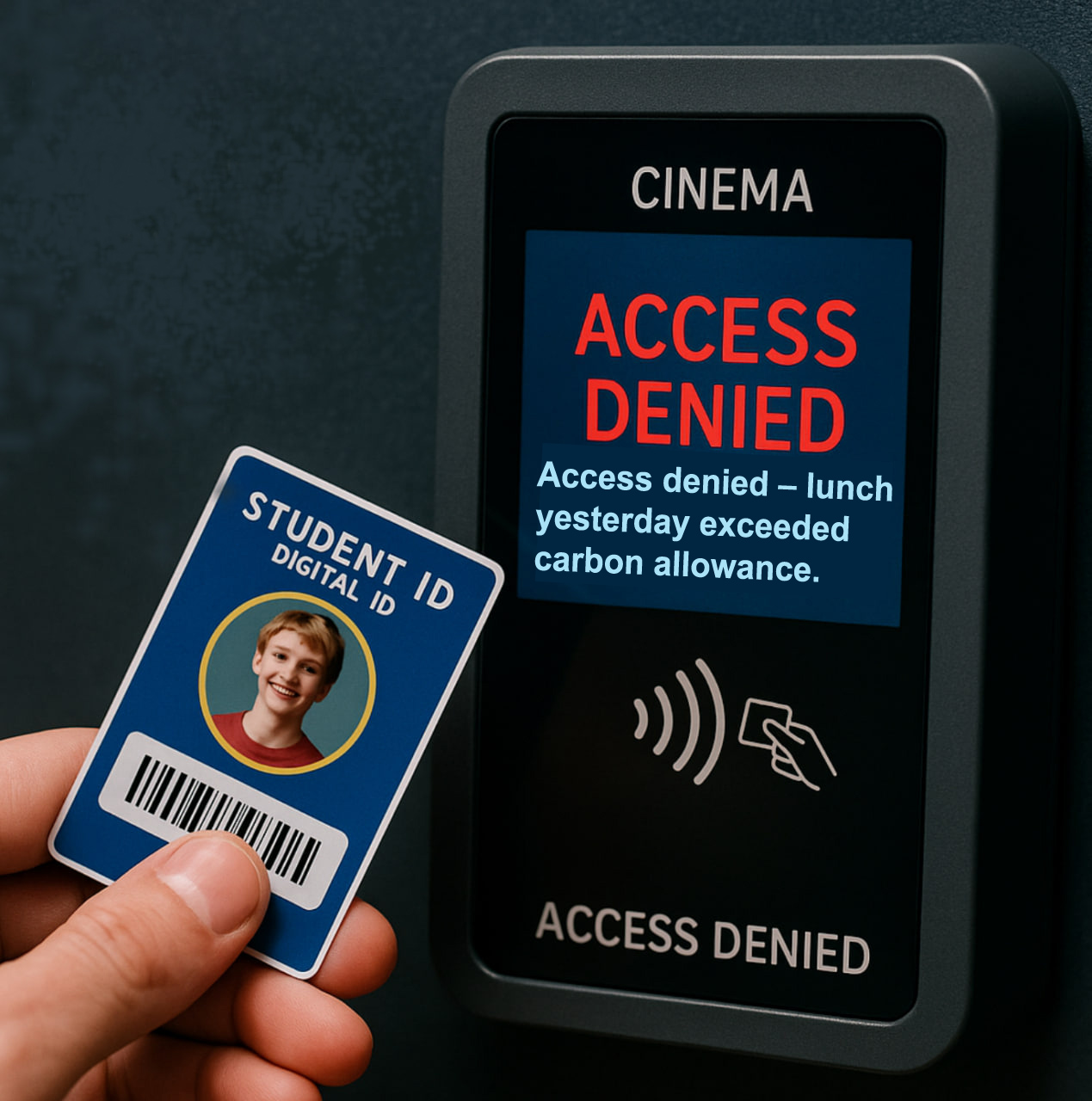From Attendance to Surveillance: The Purpose of School IDs
School–Council Data = The End of Private Family Life


Many parents think of a school ID card as a convenience—something that helps with attendance, lunch payments, or borrowing books. In reality, the new generation of “smart” IDs are entry points into the same digital-identity systems being built for adults.
1. What These Systems Collect
Modern school IDs are often linked to electronic gates, classroom scanners, homework portals, and payment apps. Every use produces data:
- attendance time stamps;
- location within school;
- meal choices and spending;
- homework completion records;
- communications between parents and staff.
The data are stored on shared council or supplier platforms, not always inside the school. Technical standards used in education technology overlap with those promoted for national “single sign-on” or “digital identity” frameworks. This means a pupil’s profile can, in principle, merge with family or council data later in life, the same backbone used for adult IDs.
2. The Current Rollout in UK Schools
Under the Children’s Wellbeing and Schools Bill (2024–25), the UK Government is preparing to introduce digital-ID systems for children aged 5–16 in both schools and home education. The Bill passed its second reading in March 2025 and is expected to complete by early 2026. Pilot programmes already use biometric or app-based IDs for:
- access control at school entry and exit;
- attendance tracking linked to council-managed databases;
- age verification for e-learning and online-safety platforms.
All of these pilots connect through the GOV.UK One Login system – the same infrastructure now used for adult verification.
Local councils sit at the centre of this network. They manage pupil records, attendance, and safeguarding data – often through private vendors such as Capita SIMS or Arbor and share those records with national bodies including the Department for Education’s National Pupil Database. That makes councils the first operational link in the chain between school data and the national identity grid.
By 2026, more than 24,000 schools in England are expected to operate within this model, potentially connecting every child’s profile to a “Brit Card” for residency and age verification.
3. Why This Feels Familiar
I grew up in a system where personal records decided everything – work, education, permission to travel and more. We carried a small identity book with official stamps showing compliance and social participation. Each classroom had a leader reporting who was present, who had homework done, and why anyone was absent. The intention was “efficiency,” but the effect was control: movement and behaviour were continuously monitored.
Today, the technology is different but the principle is similar. A digital ID that logs attendance or homework automatically can also become a tool for measuring conformity or engagement. The move from manual stamps to electronic data simply removes the physical limit that once existed.
4. Why It Matters for Families
Once data are centralised, they can be repurposed. Attendance information can merge with welfare, transport, or health databases; behavioural records can feed automated “safeguarding” or “risk” algorithms. Parents rarely see where the data travel or for how long they are kept. The result is a permanent file that begins in childhood.
The same GOV.UK One Login framework already underpins biometric verification for more than eight million company directors under the Economic Crime and Corporate Transparency Act 2023, and identity checks required by the Money Laundering Regulations 2017. The technology is one system; only the datasets differ. This is why school data matter so much—they extend the same infrastructure into every family home.
5. A Global Snapshot
School-linked digital-ID schemes are being adopted worldwide under similar language of “wellbeing” and “digital inclusion.”
| Region / Country | Initiative | Implementation Status (Oct 2025) | School Aspects | Concerns Raised |
|---|---|---|---|---|
| China | Mandatory facial recognition for school entry/exit, linked to digital currency for meals and attendance. | Fully implemented in many urban schools since 2020; nationwide expansion by 2025. | Students scan faces to enter/leave; payments via ID-linked apps. | Surveillance; privacy for minors. |
| United Kingdom | Children’s Wellbeing and Schools Bill (2024–25) mandates digital IDs for ages 5–16; ties to national “Brit Card” and GOV.UK One Login. | Bill awaiting final stage; pilots active. | Verifies student identity for entry, online learning, and SERVICES (?) | Privacy erosion; digital divide; civil-liberties concerns. |
| United States | Mobile-driver-licence IDs with biometrics in 18 states; school pilots for access. | Active rollouts in Texas and others. | App-based student IDs for bus or cafeteria access. | Cyber risks; exclusion of low-tech families. |
| Australia | National Digital ID system with mandatory under-16 age-verification for social media; school pilots for online safety. | Pilots 2025; enforcement by Dec 2025. | Links to student portals for “safe internet” use. | Echoes failed Australia Card; surveillance fears. |
| European Union | eIDAS 2.0 digital wallets with education extensions. | Pilots in 26 countries; rollout 2026. | Verifiable student credentials for exams/attendance. | Data-breach risks; uneven adoption. |
6. What Parents Can Do
Rather than protest in isolation, use your legal rights to ask questions. A single, well-written request forces transparency.
Send the Freedom of Information request provided on our main page to your local council or school authority.
It asks for:
- the legal basis for digital or biometric ID systems;
- contracts and data-sharing agreements with external suppliers;
- evidence of consent and consultation;
- copies of any Data Protection Impact Assessments (DPIAs).
You can access the full FOI template here:
[Download / Open the FOI Template ]
7. A Closing Thought
Digital identification is arriving quietly, through schools as much as through government offices. Each layer – school IDs, council accounts, national IDs – builds on the same data infrastructure. Understanding this connection is the first step to deciding how far we allow it to grow.
